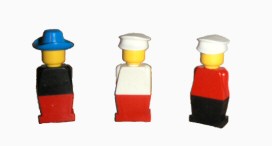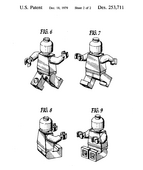Lego minifigure facts for kids
A Lego minifigure, commonly referred to as a minifig, is a small plastic articulated figurine produced by Danish toy manufacturer The Lego Group. They were first produced in 1978 and have been a success, with over 4 billion produced worldwide as of 2020. Minifigures are usually found within Lego sets, although they are also sold separately as collectables in blind bags, or custom-built in Lego stores. While some are named as specific characters, either licensed from film, television, and game franchises, or of Lego's own creation, many are unnamed and are designed simply to fit within a certain theme (such as police officers, astronauts and pirates). Minifigures are collected by both children and adults. They are highly customizable, and parts from different figures can be mixed and matched, resulting in many combinations.
Similar figures are produced by other companies, such as the Kreons from the construction toy Kre-O by the Korean company Oxford (subsidiary of Hasbro), or the figures by Block Tech or the Canadian company Mega Bloks.
There are also other types of figures from Lego sets, such as Duplo figures and mini-doll figures.
History
A precursor to the minifigure was released in 1975. These were at the same scale as the current minifigures, but had a different design. They had solid torsos without separate movable arms, solid lower body pieces that were not moveable, and heads without printed features. They had a small variety of headpieces in various colors, including caps, pigtail hair and cowboy hats.
The first modern minifigures were released in 1978, included in Castle, Space, and Town sets. These were designed by Jens Nygaard Knudsen, who had come up with the idea for having the torsos, legs, and arm pieces interchangeable. As these were made into pieces, the company decided to give them a simple facial expression, rendered as two solid black dots for eyes and a smile painted in solid black, and without any gender or racial components, believing that these factors would be "determined by the child’s imagination and play".
In 1989 for the launch of Lego Pirates theme, minifigures also included hooks for hands, as well as peg legs; this was the first departure from the traditional body parts. Starting with Lego Pirates in 1989 and spreading to Lego Town and Lego Castle in the next few years, minifigures were also produced with different facial expressions such as facial hair, eye patches, feminine makeup, and sunglasses. Most of these early facial additions were still centered around the two eyes and smile, however starting in 1997 with Willa the Witch of the Fright Knights facial expressions became more complex including open mouths and detailed eyes.
Another departure from traditional parts was the use of spring-loaded legs. These legs are joined together at the top. These legs were only featured in basketball sets, 2002–2003. Other leg variations include short legs for children or dwarfs, or long legs (used in the Toy Story theme).
In 2003, the first minifigures with naturalistic skin tones (as opposed to the yellow used until this point) were released, as part of the Lego Basketball theme; these minifigures were also created in the likeness of living people. This also included Lando Calrissian in the Star Wars theme. The following year, the use of natural skin tones was expanded to all licensed products; in which figures were created to represent film actors and other living people. Popular examples include Star Wars, Indiana Jones, Harry Potter and Batman minifigures.
By 2006, Lego had reportedly produced 4 billion minifigures. There are at least 3655 different minifigures produced between 1975 and 2010 and the number of new minifigures per year is increasing rapidly. In 2010 more than 300 new minifigures were introduced.
Design and construction
The height of a typical minifigure is 4 centimetres (1.6 in). Minifigures generally feature six parts (widely referred to as tools in the toy industry): head, torso, hips, arms, hands, and legs; these six parts allow seven points of articulation: swivel head, swivel arms, swivel wrists, and swivel legs. Minifigures are usually packaged as three separate parts in Lego sets: head, torso and legs. The plastic is acrylonitrile butadiene styrene (ABS), a tough material that makes LEGO figures durable.
The plastic is melted into specially designed molds that produce the different parts of the minifigure. Some of the molds are also accessories such as weapons (swords, guns, lightsabers, etc.) or everyday accessories (cups, food, tools, etc.). Heads and torsos nearly always need further decoration, and sometimes the arms and legs as well. This difficult process is why the figures are more expensive than any other Lego products. After being printed, the head is placed on the torso, the legs attached, and the arms are snapped on. The figures are finally bagged and readied for sale.
Use
Minifigure heads are cylindrical, and attach to a long, narrow cylinder molded onto the top of the torso, which allows the head to rotate. This feature also allows items to be attached to the figures over the torso, such as air tanks, capes or breastplates. The heads have a stud on top which is the same size as studs on standard Lego bricks which could allow one to be placed on it. The head is the only component of the minifigure which can be used for other applications - blank minifigure heads have often been used in Lego sets to replicate other objects such as lampshades and electrical appliances.
Head accessories vary widely, and include hair, helmets and hats. The legs rotate independently to 90 degrees forward, and nearly 45 degrees backward. Minifigures also connect to standard Lego bricks in both a sitting or standing position. The hands of a minifigure resemble the letter C, which allows them to hold many Lego accessories as well as bricks, tiles, and plates. There are hundreds of different accessories, including swords, axes, wands, cups, guns, and lightsabers. Additionally, the tops of the hands are approximately the same size as the studs on standard Lego bricks, which allows Lego pieces to be placed on top of them. These variations allow minifigures to be customized, keeping with the modular design of Lego elements.
Images for kids
-
Aluminum minifigures on board the Juno spacecraft: (left to right) Jupiter, Juno, and Galileo
See also
 In Spanish: Minifigura para niños
In Spanish: Minifigura para niños







